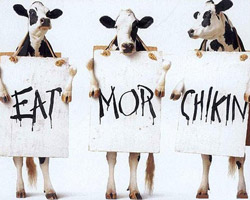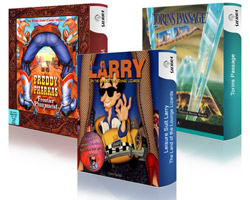In 1981, a programmer named Chuck Benton was interested in doing database programming on the Apple ][, but he wasn’t sure if the tiny machine was up to it. As a "test case" he knocked out a little text-only adventure game. It worked pretty well. People who played the game liked it. So he called up the then largest publisher of Apple games to see if they were interested. They were.
And that’s how Sierra (then named On-Line Systems) published its only non-graphic game: Softporn.
Softporn became both famous and infamous when it received prominent coverage in Time Magazine's first column on computer entertainment. Time even published the cover photo, showing a waiter delivering Champagne and an Apple ][ to three naked women in a hot tub. It was a highly successful product for its time.
How successful? Ken Williams, Sierra’s founder, swears that at a time when Apple had only sold 100,000 Apple ][ computers, Sierra had sold 25,000 copies of Softporn. (That’s even more impressive when you learn that everybody I knew that owned an Apple had a pirated copy!) Softporn was probably played by the highest percentage of computer owners of any game in history.
But soon thereafter, Sierra had the chance to acquire the software rights for all the Walt Disney characters…if they dropped that "nasty" game from the catalog. So of course they did. In fact, I wrote several titles for that Disney series. But, after a few years, the rights to the characters reverted back to Disney, which has kept them ever since.
So what does this have to do with Leisure Suit Larry?
In late 1986, I had just finished programming Roberta Williams's King's Quest III, and was talking with Ken Williams about my next project. We realized there were no games on the market that were adult in nature--everything was "save the princess" or "save the galaxy." We reminisced a little about the old days and Softporn came up. Ken suggested I do an up-dated version, with "modern hi-res, 3-D" graphics, music, everything?
Since I hadn't played the game in years, I said I’d have to take a copy home and play it before deciding.
Wow. Was it out of date! Its goal was to score three women during one night in Las Vegas. It had no protagonist, little or no plot, almost no text, understood almost no input. So I reported back to Ken: there’s no way I could bring this game into the 80’s unless he let me make fun of that life style. I said, "it’s so behind the times it might as well be wearing a leisure suit!" Everyone laughed. Hey, wait a minute....
Thus was born Leisure Suit Larry.
 Back then, there were no graphics tools for PC’s, so Sierra had to create them. Consequently, they were always short of qualified artists. For the Leisure Suit Larry game, they could only spare Mark Crowe for four weeks because he was working full-time on another project (which became Space Quest I)! Mark worked weekends and evenings and busted his butt. After only four short weeks, he actually created everything you see on the screen in Land of the Lounge Lizards (although both Scott Murphy and I believe he sneaked a little Larry-time into his SQ-only-time).
Back then, there were no graphics tools for PC’s, so Sierra had to create them. Consequently, they were always short of qualified artists. For the Leisure Suit Larry game, they could only spare Mark Crowe for four weeks because he was working full-time on another project (which became Space Quest I)! Mark worked weekends and evenings and busted his butt. After only four short weeks, he actually created everything you see on the screen in Land of the Lounge Lizards (although both Scott Murphy and I believe he sneaked a little Larry-time into his SQ-only-time).
Softporn’s puzzles, characters, and locations were all solid. I kept them all, although I’ve always regretted the "give the whiskey to the drunk" to get a remote control. I now wish I would have come up with something better.
But—the game had no sense of humor whatsoever. I decided to make fun of the main character whenever possible, mostly through the narrator’s voice (which was, of course only text in the original game).
Softporn had no central character. The text referred to the player as "master" and the game itself as a "puppet." I decided to only refer to Larry as "you," even though, obviously, "you" were typing and controlling a character named Larry. To me, saying "you take the key" made you feel more involved than "Larry takes the key." It seems to have worked. Almost everyone I've spoken with says things like "How do I get the key?" never "How do I make Larry get the key?"
Softporn had mostly one description per scene. Since Mark Crowe’s background graphics were so detailed (especially for the state of the graphics art back then), I ended up adding hundreds of "look at that thing" messages. To keep the player interested, I tried to make the messages that gave clues clear and to make the rest humorous.
I believe I only kept one sentence of Chuck’s text. I loved his description of Lefty’s back room, something about "the peeling paint gives the roaches something to watch."
Since the game wasn’t too big, I got it done in about three months. But this was the first non-children’s game I had written, so I was scared to death it would be "dumb" and not understand everything a player could type in.
So I convinced Ken we should try something new: beta-testing. He posted an announcement on CompuServe's Gamers Forum asking anyone interested in beta-testing a new game should e-mail him a 100-word essay on "why I should get a free game." It worked. We got scores of replies and ended up with a dozen great beta testers.
To track all the "you can’t do that here" errors (which is what the game says when it doesn’t have a clue what in the hell you typed it!), I wrote a special piece of code. Instead of just saying that phrase, it wrote a line to a file on the player's game floppy. (Hard disks were few and far between back then.) That line told me the scene number, location, the phrase typed, and many other details about the state of the game at that time. I compiled all those files, sorted them scene by scene and added literally hundreds of responses to the game.
Those testers came up with some great inputs, showing where and when they were frustrated. And because of them, the game makes you think it understands much more than most games of that period.
After two months of testing and refinement, we finally shipped the game in June, 1987—to the worst initial sales in the history of Sierra! The game only sold 4,000 copies the first month. I figured I had just blown six months of my life, and had better do something fast, so when I was offered the chance to take over the programming on Police Quest I, I jumped at it.
While I worked day and night to get PQ out in time for Christmas, Larry did a strange thing. Word of mouth kept building, and every month it would see twice as many copies as the month before. By the new year, it was a huge hit.
In February, 1988, something happened that, as far as I know, remains unique in the games business: Police Quest had had a good Christmas, King’s Quest III was still selling like crazy, and Leisure Suit Larry had finally reached big numbers. For a grand total of one week, three games that I had programmed made the Softsell Top 10 simultaneously!
One of my favorite Larry stories was when Hollywood called and wanted to do a movie based on Larry. No one at the studio who could make a decision had ever seen a computer, let alone played a computer game, so they flew me to Hollywood to demonstrate the game. There must have been 25 management types sitting around a big conference table, while I played the game for them. To get them involved, I asked them to call out what they wanted me to type. We were in Lefty’s bathroom when some smart-ass yelled, "masturbate." I had no idea if I handled that input or not, but I dutifully typed it in. They started applauding when the answer popped up on screen: "The whole idea was to stop doing that, Larry!"





